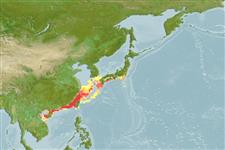分類 / Names
俗名 | 同種異名 | Catalog of Fishes(屬, 種) | ITIS | CoL | WoRMS | Cloffa
Teleostei >
Gobiiformes (Gobies)
鱸形目 (Gobies) >
Gobiidae (Gobies)
鰕虎魚科 (Gobies) > Gobiinae
Etymology: Tryssogobius: Greek, tryo, tryso = to wear away + see under Gobius; porosus: Named for its preopercular pores and those over the opercle, the main distinguishing feature of the species.
More on authors: Larson & Chen.
Environment: milieu / climate zone / depth range / distribution range
生態學
海洋 底中水層性; 深度上下限 18 - 100 m (Ref. 58420). 溫帶
分布
國家 | FAO區域 | 生態系 | 發現紀錄 | Point map | 簡介 | Faunafri
Northwest Pacific: China and Taiwan.
西北太平洋: 中國與台灣。
大小 / 重量 / 年齡
Maturity: Lm ? range ? - ? cm
Max length : 2.8 cm SL 雄魚/尚未辨別雌雄; (Ref. 58420); 2.6 cm SL (female)
簡短描述
檢索表 | 型態特徵 | 形態測量圖
背棘 (總數) : 7; 背的軟條 (總數) : 9; 臀棘: 1; 臀鰭軟條: 10; 脊椎骨: 26. This species is distinguished by the following characters: preopercular canal with 3 pores and 2 pores over opercle; color in life translucent with yellow markings on the body and fins, with a distinctive dense black oval blotch posteriorly on first dorsal fin; 5th -8th caudal fin rays usually elongate and filamentous, extending beyond other rays; branchiostegal membranes with one cycloid scale on each side; second dorsal fin I, 9; anal fins I, 10; pectoral fin rays 20-21 (Ref. 58420).
這種被藉著下列的特徵區別: 前鰓蓋骨管有三個在鰓蓋上的孔與 2個孔; 顏色活著時半透明的在身體與鰭上有黃色的斑紋, 具有一個特殊的密集黑色的橢圓形的斑塊在第一背鰭後面; 第 5-第 8個尾鰭鰭條通常延長與絲狀的, 延伸超過其他的鰭條; 鰓蓋薄膜在兩邊上有一圓形的鱗片; 第二背鰭鰭 I, 9; 臀鰭 I, 10; 胸鰭鰭條 20-21.(參考文獻 58420)
Specimens trawled from muddy substrate (Ref. 58420).
標本以拖網捕獲自泥濘的底部。 (參考文獻 58420)
Life cycle and mating behavior
成熟度 | 繁殖 | 產卵場 | 卵 | 孕卵數 | 仔魚
西北太平洋: 中國與台灣。
Larson, H.K. and I.-S. Chen, 2007. A new species of Tryssogobius (Teleostei, Gobiidae) from Hianan Island, China and Taiwan. Zool. Stud. 46(2):155-161. (Ref. 58420)
IUCN 瀕危狀態 (Ref. 130435: Version 2024-1)
人類使用
漁業:
工具
特別的報告
下載 XML
網路資源
Estimates based on models
Preferred temperature (Ref.
123201): 21.9 - 25.1, mean 23.7 °C (based on 29 cells).
Phylogenetic diversity index (Ref.
82804): PD
50 = 0.5078 [Uniqueness, from 0.5 = low to 2.0 = high].
Bayesian length-weight: a=0.01023 (0.00477 - 0.02194), b=3.01 (2.83 - 3.19), in cm total length, based on LWR estimates for this (Sub)family-body shape (Ref.
93245).
營養階層 (Ref.
69278): 3.1 ±0.3 se; based on size and trophs of closest relatives
回復力 (Ref.
120179): 高度, 族群倍增時間少於 15個月 (Preliminary K or Fecundity.).
Fishing Vulnerability (Ref.
59153): Low vulnerability (10 of 100).
